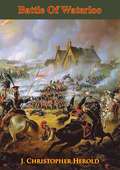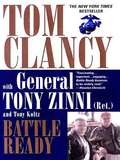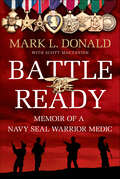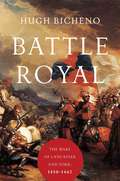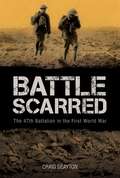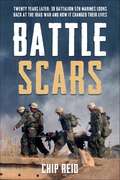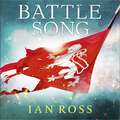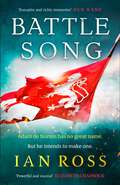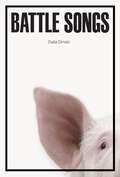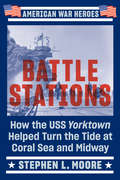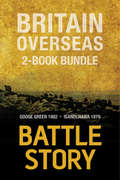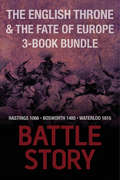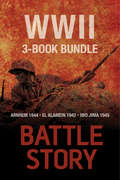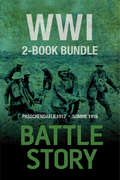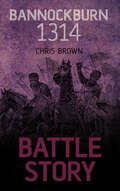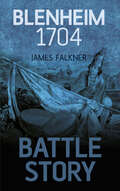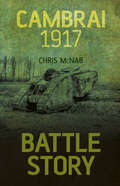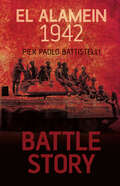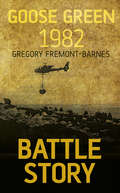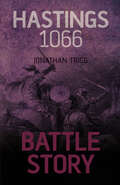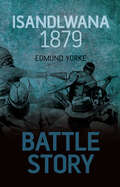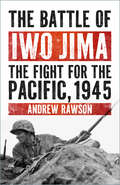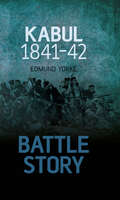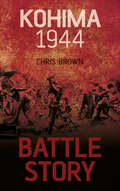- Table View
- List View
Battle Of Waterloo [Illustrated Edition]
by J. Christopher Herold Jean HanoteauIllustrated with documents, paintings, and relics of the period. Renowned Napoleonic historian, J. Christopher Herold recounts the fascinating details of the great battle of Waterloo which ended the career of the greatest conqueror of modern times--Napoleon Bonaparte, Emperor of the French.
Battle Ready
by Tom Clancy Tony Koltz Tony ZinniMarine general Tony Zinni was known as the "Warrior Diplomat" during his nearly forty years of service. His credentials as a soldier were impeccable, whether he was leading troops in Vietnam, commanding hair-raising rescue operations in Somalia, or - as Commander in Chief of CENTCOM - directing strikes against Iraq and Al Qaeda. But it was as a peacemaker that he made just as great a mark - conducting dangerous troubleshooting missions all over Africa, Asia, and Europe, and then serving as Secretary of State Colin Powell's special envoy to the Middle East, before disagreements over the 2003 Iraq war and its probable aftermath caused him to resign." Battle Ready follows the evolution of both General Zinni and the Marine Corps, from the cauldron of Vietnam through the operational revolution of the '70s and '80s, to the new realities of the post-Cold War, post-9/11 military - a military with a radically different tools for accomplishing it. Opinions differ sharply about just what that job and those tools should be - and General Zinni makes it clear where he stands.
Battle Ready: Memoir of a Navy SEAL Warrior Medic
by Scott Mactavish Mark L. Donald“Mark is a true American hero. [His memoir] is a well-written journey from training to combat to recovery.” —Howard Wasdin, New York Times–bestselling author of Seal Team SixAs A SEAL and combat medic, Mark Donald served his country with valorous distinction for almost twenty-five years and survived some of the most dangerous combat actions imaginable.From the rigors of BUD/S training to the horrors of the battlefield, Battle Ready dramatically immerses the reader in the unique life of the elite warrior-medic who advances into combat with life-saving equipment in one hand and life-taking weapons in the other. It is also an uplifting human story that reveals how a young Hispanic American bootstrapped himself out of a life that promised a dead-end future by enlisting in the military. That new life begins with the Marines and includes his heroic achievements on the battlefield and the operating table, and finally, of his inspirational triumph over the demons caused by Post Traumatic Stress Disorder that threatened to destroy him and his family.“A compelling account of a remarkable American’s journey in the military.” —Wade Ishimoto, Former Senior Advisor to Assistant Secretary of Defense, Special Operations/Low Intensity Conflict“Straightforward reflections on what it takes to be the most elite sort of soldier and the hidden costs of that life.” —Kirkus Reviews“A superb description of the infamously brutal weeding-out ordeal of SEAL training, the nuts-and-bolts duties of a medic, and the battle actions that won [Donald] the Navy Cross.” —Publishers Weekly
Battle Royal: 1440-1462 (The\wars Of Lancaster And York Ser. #01)
by Hugh BichenoThe enthralling story of the dynastic wars fought between the houses of Lancaster and York, the first of a dynamic two-volume history of the Wars of the Roses. England, 1454. A kingdom sliding into chaos. The mentally unstable King Henry VI, having struggled for a decade to contain the violent feuding of his dukes, is losing his mind. Disgruntled nobles support the regal claims of Richard, Duke of York, great-grandson of Edward III. The stage is set for civil war. The first volume of an enthralling two-part history of the dynastic wars fought between the houses of Lancaster and York, Battle Royal traces the conflict from its roots in the 1440s to the early 1460s—a period marked by the rise and fall of Richard of York, the deposition of Henry VI following the Lancastrian defeat at Towton, and the subsequent seizure of his throne by Richard's son Edward. Populating this late-medieval saga of ambition, intrigue, and bloodshed are such fascinating characters as the vacillating Henry VI himself, his indefatigable queen Marguerite of Anjou, Richard of York (father of kings but never king himself), his opportunist ally Richard Neville—"the Kingmaker"—and the precociously virile Edward of York. Charting a clear course through the dynastic complexities of fifteenth-century power politics, and offering crisply authoritative analysis of the key battles of the Wars of the Roses, Battle Royal is a dynamic and rigorously researched account of England's longest and bloodiest civil war.
Battle Scarred: The 47th Battalion in the First World War
by Craig Deayton"The dead and wounded of the 47th lay everywhere underfoot". With these words Charles Bean, Australia's Official War Historian, described the battlefield of Dernancourt on the morning of the 5th of April, 1918, strewn with the bodies of the Australian dead. It was the final tragic chapter in the story of the 47th Australian Infantry Battalion in the First World War. One of the shortest lived and most battle hardened of the 1st Australian Imperial Force's battalions, the 47th was formed in Egypt in 1916 and disbanded two years later having suffered one of the highest casualty rates of any Australian unit. Their story is remarkable for many reasons. Dogged by command and discipline troubles and bled white by the desperate attrition battles of 1916 and 1917, they fought on against a determined and skilful enemy in battles where the fortunes of war seemed stacked against them at every turn. Not only did they have the misfortune to be called into some of the A.I.F.'s most costly campaigns, chance often found them in the worst places within those battles. Though their story is one of almost unrelieved tragedy, it is also story of remarkable courage, endurance and heroism. It is the story of the 1st A.I.F. itself - punished, beaten, sometimes reviled for their indiscipline, they fought on - fewer, leaner and harder - until final victory was won. And at its end, in an extraordinary gesture of mateship, the remnants of the 47th Battalion reunited. Having been scattered to other units after their disbandment, the survivors gathered in Belgium for one last photo together. Only 73 remained.
Battle Scars: Twenty Years Later: 3d Battalion 5th Marines Looks Back at the Iraq War and How it Changed Their Lives
by Chip ReidA unique insight into how combat in Iraq has shaped the lives of a battalion of young Marines. The most eye-opening, and terrifying, story in Chip Reid's career as a journalist was the six weeks he spent with 3d Battalion, 5th Marines, during the invasion of Iraq in 2003, as a correspondent for NBC News. Traveling shoulder-to-shoulder with the young Marines, he had unparalleled access, witnessing them in combat, and interviewing as many as he could persuade his bosses to put on air, allowing them to tell their war stories in their own words. It took only 22 days for the Marines of 3/5 to fight their way to Baghdad, but the effects on those who fought have lasted a lifetime. They lost a number of their own in battle, and others suffered life-threatening injuries. Of those who returned - even if they avoided physical scars - many have had to find their own way through survivor's guilt and the nightmare of Post-Traumatic Stress Disorder, with all its attendant miseries. Twenty years on, Chip sat down with the Marines of 3/5 once more. They told Chip inspiring stories of heroism in battle, of camaraderie and comrades lost, of patriotism and belief in mission, of recovery and success in both military and civilian life, and of the new appreciation for life that results from Post-Traumatic Growth. Visceral and searingly honest, this book is a tribute to the Marines for their service, and for the many sacrifices they made then, and that many still make today.
Battle Song: The 13th century historical adventure for fans of Bernard Cornwell and Ben Kane (de Norton trilogy)
by Ian Ross'There is a fury in England that none shall suppress - and when it breaks forth it will shake the throne'1264 Storm clouds are gathering as Simon de Montfort and the barons of the realm challenge the power of Henry III. The barons demand reform; the crown demands obedience. England is on the brink of civil war. Adam de Norton, a young squire devoted to the virtues of chivalry, longs only to be knighted, and to win back his father's lands. Then a bloody hunting accident leaves him with a new master: the devilish Sir Robert de Dunstanville, who does not hesitate to use the blackest stratagems in pursuit of victory. Following Robert overseas, Adam is introduced to the ruthless world of the tournament, where knights compete for glory and riches, and his new master's methods prove brutally effective. But as England plunges into violence, Robert and Adam must choose a side in a battle that will decide the fate of the kingdom. Will they fight for the king, for de Montfort - or for themselves? Searingly vivid and richly evocative, Battle Song is tale of friendship and chivalry, rivalry and rebellion, and the medieval world in all its colour and darkness.(P) 2023 Hodder & Stoughton Limited
Battle Song: The 13th century historical adventure for fans of Bernard Cornwell and Ben Kane (de Norton trilogy)
by Ian Ross'A very promising historical adventure' - THE TIMES***'There is a fury in England that none shall suppress - and when it breaks forth it will shake the throne'1264 Storm clouds are gathering as Simon de Montfort and the barons of the realm challenge the power of Henry III. The barons demand reform; the crown demands obedience. England is on the brink of civil war. Adam de Norton, a young squire devoted to the virtues of chivalry, longs only to be knighted, and to win back his father's lands. Then a bloody hunting accident leaves him with a new master: the devilish Sir Robert de Dunstanville, who does not hesitate to use the blackest stratagems in pursuit of victory. Following Robert overseas, Adam is introduced to the ruthless world of the tournament, where knights compete for glory and riches, and his new master's methods prove brutally effective. But as England plunges into violence, Robert and Adam must choose a side in a battle that will decide the fate of the kingdom. Will they fight for the king, for de Montfort - or for themselves? Searingly vivid and richly evocative, Battle Song is tale of friendship and chivalry, rivalry and rebellion, and the medieval world in all its colour and darkness.
Battle Song: The 13th century historical adventure for fans of Bernard Cornwell and Ben Kane (de Norton trilogy)
by Ian Ross'A very promising historical adventure' - THE TIMES'A terrific novel' - HISTORIA MAGAZINE***'There is a fury in England that none shall suppress - and when it breaks forth it will shake the throne'1264 Storm clouds are gathering as Simon de Montfort and the barons of the realm challenge the power of Henry III. The barons demand reform; the crown demands obedience. England is on the brink of civil war. Adam de Norton, a young squire devoted to the virtues of chivalry, longs only to be knighted, and to win back his father's lands. Then a bloody hunting accident leaves him with a new master: the devilish Sir Robert de Dunstanville, who does not hesitate to use the blackest stratagems in pursuit of victory. Following Robert overseas, Adam is introduced to the ruthless world of the tournament, where knights compete for glory and riches, and his new master's methods prove brutally effective. But as England plunges into violence, Robert and Adam must choose a side in a battle that will decide the fate of the kingdom. Will they fight for the king, for de Montfort - or for themselves? Searingly vivid and richly evocative, Battle Song is tale of friendship and chivalry, rivalry and rebellion, and the medieval world in all its colour and darkness.***Readers absolutely love BATTLE SONG:'Another five star Ian Ross novel!' *****'Truly is a masterclass in historical fiction' *****'The best historical fiction I've read in years. Up there with Hilary Mantel!' *****'A great well researched novel' *****'Brilliantly researched, gorgeously plotted and blessed with a terrific cast of exquisitely drawn characters' *****'Well written and engaging characters' *****'Ian Ross writes with a class and style that leaves the reader or listener thirsting for more' *****'Brilliantly researched, gorgeously plotted and blessed with a terrific cast of exquisitely drawn characters' *****'A gripping tale of early England' *****'A really good story, brought to life by an excellent narrator' *****
Battle Songs
by Daša DrndicAn early novel from the masterful Drndic, Battle Songs is an intimate, ferocious account of her years spent as a refugee in Canada during the Yugoslav Wars In the 1990s, the unnamed narrator of Battle Songs leaves Yugoslavia with her daughter Sara to Toronto to start a new life. They, along with other refugees, encounter a new country but not a new home. Book editors sell hotdogs, mathematicians struggle to get by on social security, violinists hawk cheap goods on the street. Years after arriving in Canada, when she thinks no one can hear her, Sara still sings in the shower: What can we do to make things better, what can we do to make things better, la-la-la-la. In true Drndic style, the novel has no one time or place. It is interspersed with stories from the Yugoslav Wars, from Rijeka to Zagreb to Sarajevo—with, as always, the long shadow of the Second World War looming overhead. Her singular layering of details—from lung damage to silk scarves to the family budget to old romances—offers an almost unbearable closeness to the characters and their moment in history. “Wry and kindly, funny, angry, informed and intent on the truth, no voice is quite as blisteringly beautiful as that of Drndic” (Financial Times).
Battle Stations: How the USS Yorktown Helped Turn the Tide at Coral Sea and Midway (American War Heroes)
by Stephen L. MooreThe true story of the valiant men who gave their all to save the aircraft carrier USS Yorktown—and changed the course of the Pacific War. On June 4, 1942—six months after the attack on Pearl Harbor—Yorktown&’s crew began the carrier&’s final battle against Japan&’s infamous aircrafts. Hotshot fighter pilot Lieutenant Scott McCuskey attacked from the air in his Wildcat, becoming the Navy&’s second-ever &“ace in a day.&” Carpenter Boyd McKenzie worked tirelessly to repair Yorktown before a fresh air strike. Critically injured gun crew member George Weise fought for his life as the ship threatened to capsize. Meanwhile, Pharmacist&’s Mate Second Class Warren Heller raced to save the lives of bloodied gunners and sailors by evacuating them before time ran out. The stories of these heroes and many other brave servicemen bring the gripping narrative of Yorktown&’s final thirty days to life, as she fights in the near back-to-back Battles of Coral Sea and Midway. Through unpublished memoirs and interviews with Yorktown&’s last surviving veterans, acclaimed author Stephen L. Moore offers up a new and compelling amount of a pivotal month in World War II, while honoring the courage of those who served.
Battle Stories — Britain Overseas 2-Book Bundle: Goose Green 1982 / Isandlwana 1879
by Gregory Fremont-Barnes Edmund YorkeTwo pivotal moments in British military history, separated by more than a century, yet both with decisive impacts on Britain’s national identity and power overseas. At Isandlwana, South Africa, as at Goose Green in the Falkland Islands, British commanders underestimated local forces and found themselves unprepared for the full extent of combat on the ground. One engagement ended in disaster and a total rethinking of tactics. The other, thanks to hard lessons learned, ended in British victory. Two renowned experts tell the full stories of both battles, complete with detailed profiles of key figures and a moment-to-moment breakdown of history in the making. Isandlwana 1879 On January 22, 1879, a 20,000-strong Zulu army attacked 1,700 British and colonial forces. The engagement saw primitive weapons of spears and shields clashing with the latest military technology. However, despite being poorly equipped, the numerically superior Zulu force crushed the British troops, killing 1,300 men, while only losing 1,000 of their own warriors. It was a humiliating defeat for the British Army, which had been poorly trained and which had underestimated its enemy. The defeat ensured that the British had a renewed respect for their opponents and changed their tactics; rather than fighting in a straight, linear formation, known as the Thin Red Line, they adopted an entrenched system or close order formations. The defeat caused much consternation throughout the British Empire, which had assumed that the Zulu were no match for the British Army; thus, the army was greatly reinforced and went on to victory at Rorke’s Drift. Isandlwana 1879 puts you at the forefront of the action. Goose Green 1982 The Battle for Goose Green has become an integral part of the Falklands story, and yet it nearly didn’t take place at all. Originally earmarked to be isolated, Goose Green was eventually attacked due to the loss of momentum in the invasion force. The British 2 Para Regiment were deployed against the 12th Argentinean Regiment, which numbered about 1,200 men. The British believed that the Argentinean force numbered at least half this and set off with a strength of 690 men. They took two days’ rations, weapons, and ammunition in the belief that it would be a swift conquest. There followed a bitter and bloody fight as the Argentine forces fiercely defended Goose Green. Despite reconnaissance, the British were hampered by trench systems that they had been unaware of. It was the first major engagement of the Falklands War.
Battle Stories — The English Throne and the Fate of Europe 3-Book Bundle: Hastings 1066 / Bosworth 1485 / Waterloo 1815
by Gregory Fremont-Barnes Mike Ingram Jonathan TriggThree battles that shook the British Isles and changed the course of world history. Three renowned experts each take up one crucial day when the future of the throne, or Europe itself, hung in the balance. Hastings 1066 In 1066, a foreign invader won the throne of England in a single battle and changed not only the history of the British Isles, but that of Christendom, forever. Harold Godwinson’s army, exhausted from their victory against an invading Norwegian Viking army at the Battle of Stamford Bridge in the north, and his navy, scattered by storms, could not hold back William of Normandy. But would the invasion have succeeded if the two armies had met on equal terms? Bosworth 1485 Bosworth Field saw the two great dynasties of the day clash on the battlefield: the reigning House of York, led by Richard III, and the rising House of Tudor, led Henry Tudor, soon to become Henry VII. On August 22, 1485, this penultimate battle in the Wars of the Roses was fought with the might of the Yorkists ranged against Tudor’s small army. This book describes how these two great armies came to meet on the battlefield, and how the Tudor tactics eventually led to the downfall and death of King Richard III. Waterloo 1815 The might of the French Empire under the leadership of the Emperor Napoleon faced the Coalition army under Duke of Wellington and Gerhard von Blucher for one last time at Waterloo. The battle saw the culmination of a long campaign to destroy Napoleon’s forces and halt the growth of the French Empire. Both armies lost over 20,000 men on the battlefield that day, but it was the coalition that emerged victorious in the end. Wellington’s counter-attack threw the French troops into disarray, a resounding victory for the British Army that changed the course of European history.
Battle Stories — The WWII 3-Book Bundle: El Alamein 1942 / Arnhem 1944 / Iwo Jima 1945
by Chris Brown Pier Paolo Battistelli Andrew RawsonThree battles that changed the course of WWII and echo through world history to the present day. Three renowned experts each take up one of these crucial engagements. Iwo Jima 1945 Operation Detachment, the invasion of Iwo Jima, on February 19, 1945, was the first campaign on Japanese soil, and it resulted in some of the fiercest fighting of the Pacific campaign. El Alamein 1942 El Alamein saw two of the greatest generals of the war pitted against each other: Rommel and Montgomery. Arnhem 1944 When we think of Arnhem, we think of a bridge too far and a sky full of parachutes dropping the Allies into the Netherlands. It was one of the most complex and strategically important operations of the war.
Battle Stories — WWI 2-Book Bundle: Somme 1916 / Passchendaele 1917
by Chris Mcnab Andrew RobertshawDiscover two pivotal battles of the First World War in this collection of Battle Stories. Somme 1916 The Battle of the Somme was one of the bloodiest fought in military history. It has come to signify for many the waste and bloodshed of the First World War, as hundreds of thousands of men on all sides lost their lives fighting over small gains in land. Yet this battle was also to mark a turning point in the war and to witness new methods of warfare. In this Battle Story, Andrew Robertshaw seeks to lift the battle out of its controversy and explain what really happened and why. Passchendaele 1917 Passchendaele is perhaps one of the most iconic campaigns of the First World War, coming to symbolize the mud and blood of the battlefield like no other. Fought for over three months under some of the worst conditions of the war, fighting became bogged down in a quagmire that made it almost impossible for any gains to be made.
Battle Story: Bannockburn 1314
by Chris BrownBannockburn 1314 is the most celebrated battle between Scotland and England, in which a mere 7,000 followers of Robert the Bruce defeated more than 15,000 of Edward II’s troops. The Battle of Bannockburn, fought over two days on 23 and 24 June 1314 by a small river crossing just south of Stirling, was a decisive victory for Robert, and secured for Scotland de facto independence from England. It was the greatest defeat the English would suffer throughout the Middle Ages, and a huge personal humiliation for Edward. Chris Brown’s account recreates the campaign from the perspectives of both the Scots and English. If you want to know what happened and why read – Battle Story.
Battle Story: Blenheim 1704
by James FalknerBlenheim has gone down in history as one of the turning points of the War of the Spanish Succession – and some would say in the history of conflict in Europe. The overwhelming Allied victory ensured the safety of Vienna from the Franco-Bavarian army, thus preventing the collapse of the Grand Alliance. Bavaria was knocked out of the war, and Louis's hopes for a quick victory came to an end. France suffered over 30,000 casualties including the commander-in-chief, Marshal Tallard, who was taken captive to England. Before the 1704 campaign ended, the Allies had taken towns on the Moselle in preparation for the following year's campaign into France itself. It was a brilliant victory for Marlborough, which involved a lightning march of over 250 miles and superb deception – even of his own Dutch allies! Blenheim must be one of the most well known battles – because of Blenheim Palace – but few know why.
Battle Story: Cambrai 1917
by Chris McNabCambrai 1917 was the battle that sowed the seeds of future combined-arms tank and infantry warfare, while remaining a battle of singular drama in its own right. If you truly want to understand what happened and why – read Battle Story. Detailed profiles explore the background of the generals of the two opposing forces, as well as what made up the average German and British soldier. First-person, contemporary sources bring the reader into the world of the Battle of Cambrai and show what it was like to be in the thick of battle. Detailed maps highlight key points in the battle and the surrounding area. Photographs place you on the front line of the unfolding action. Orders of battle reveal the composition of the two opposing forces’ army in detail. Packed with fact boxes, this short introduction is the perfect way to explore this important battle.
Battle Story: El Alamein 1942
by Pier Paolo BattistelliThe Second Battle of El Alamein marked a major turning point in the Western Desert Campaign of the Second World War. El Alamein saw tow of the greatest generals of the war pitted against each other: Rommel and Montgomery. Through key profiles and a chapter devoted to 'The Armies' Battle Story: El Alamein explores what made these men inspired leaders and what led to their respective defeat and victory. Montgomery's success ensured that the Axis army was unable to occupy Egypt and therefore gain control of the Suez Canal or the Middle Eastern oil fields, thereby preventing a major source of income and power for them. The background and impact of the battle are explored in separate chapters, so offering the reader a clear insight into why what happened in this remote part of Egypt was so central to the Allied cause. Through quotes and maps the text explore the unfolding action of the battle and puts the reader on the frontline. If you truly want to understand what happened and why - read Battle Story.
Battle Story: Goose Green 1982
by Gregory Fremont-BarnesThe Battle of Goose Green was the first and longest land conflict of the Falklands War, which was fought between British and Argentine forces in 1982. The British forces, attacking over featureless, wind-swept and boggy ground, were heavily outnumbered and lacked fire support, but brilliantly defeated the Argentine garrison in a fourteen-hour struggle. If you want to understand what happened and why – read Battle Story. Detailed profiles examine the personalities of the British and Argentine commanders, including that of Victoria Cross winner Lt Col ‘H’ Jones. First-hand accounts offer an insight into this remarkable fourteen-hour struggle against the odds. Detailed maps explore the area of Darwin Hill and Goose Green, and the advance of the British forces. Photographs place you at the centre of this pivotal battle. Orders of battle show the composition of the opposing forces’ armies. Packed with fact boxes, this short introduction is the perfect way to explore this crucial battle.
Battle Story: Hastings 1066
by Jonathan TriggIn 1066 the most significant battle on English soil – and arguably the most important in British history – took place some six miles northwest of Hastings. A king would die on the battlefield and a new dynasty would be established. The fighting exemplified the superiority of an all-arms combined attack employing foot soldiers, cavalry and archers against massed infantry. To understand what happened and why – read Battle Story. Photographs of the battlefield today, artist’s interpretations and of course reproductions from the Bayeux tapestry place you in the centre of the action. Easy-to-read maps plot each development in the struggle. Descriptions of the weaponry, armour and tactics of the combatants help explain why the famous housecarls of England were obliterated for all time. Packed with fact boxes, this short introduction is the perfect way to explore a turning point in British and European history.
Battle Story: Isandlwana 1879
by Edmund YorkeOn 22 January 1879 a 20,000-strong Zulu army attacked 1,700 British and colonial forces. The engagement saw primitive weapons of spears and shields clashing with the latest military technology. However, despite being poorly equipped, the numerically superior Zulu force crushed the British troops, killing 1,300 men, whilst only losing 1,000 of their own warriors. It was a humiliating defeat for the British Army, who had been poorly trained and who had underestimated their enemy. The defeat ensured that the British had a renewed respect for their opponents and changed their tactics, rather than fighting in a straight, linear formation, known as the Thin Red Line they adopted an entrenched system or close order foundations. The defeat caused much consternation throughout the British Empire, who had assumed that the Zulu were no match for the British Army and thus the army was greatly reinforced and went on to victory at Rorke's Drift. Battle Story: Isandlwana puts you at the forefront of the action.
Battle Story: Iwo Jima 1945 (Battle Story #1)
by Andrew RawsonOperation Detachment, the US invasion of Iwo Jima on 19 February 1945, was the first campaign on Japanese soil and resulted in some of the fiercest fighting in the Pacific. If you truly want to understand what happened and why – read this battle story.Detailed profiles explore the leaders, tactics and equipment of the US and Japanese armies. Nine specially commissioned maps track the progress of the battle and the shifting frontlines. Rare photographs place you in the centre of the unfolding action. Diary extracts and quotes give you a soldier’s eye-view of the battle. Orders of Battle reveal the composition of the opposing forces’ armies.Packed with fact boxes, this short introduction is the perfect way to explore this important battle.
Battle Story: Kabul 1841-42
by Edmund YorkeKabul is a name that has had much resonance in current affairs over the last few years, however its place in military history can be charted much further back to the first British incursions into Afghanistan during the 19th century. The First Anglo-Afghan War saw British India attempting to obtain power over Central Asia by gaining control of Afghanistan. The British had little understanding or appreciation of the terrain or tribal warfare in Afghanistan and incurred heavy casualties, despite being far superior in training and weaponry than the Afghan warriors they faced. In 1841 the British, having held Kabul for several years in an attempt to stop the Afghans colluding with the Russians, relaxed their grip on the garrison, allowing the Afghans to rebel, leading to the slaughter of over 16,000 British and Indian troops and camp followers. The outrage from the disaster resounded throughout the British Empire and reinforcements were sent to Afghanistan in 1842 to quell the Afghan troops. However, a rash of uprisings broke out around Kabul, leading to the murder of Indian sepoys and the imprisonment of British officers. In retribution an army was sent to support the British retreat from Afghanistan, laying waste to the city of Kabul on their way.
Battle Story: Kohima 1944 (Battle Story)
by Chris BrownKohima was the turning point in the Japanese invasion of India, witnessing the end of their attempt to overthrow the British Raj. It was a bitter battle fought in three stages, spanning three months and ending with the siege of Imphal. Losses on both sides were heavy, with the Japanese suffering their greatest land defeat thus far in the war. Against the odds and an enemy who nearly refused to give in, the British Army resisted the Japanese and their victory paved the way for the reconquest of Burma. Battle Story: Kohima explores the historical context of this critical point in the war in Asia, the personalities of the opposing armies and offers a blow-by-blow account of the battle.
